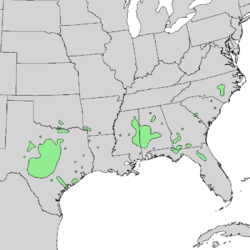Biology:Quercus sinuata
| Quercus sinuata | |
|---|---|

| |
| Foliage and ripening acorns of Quercus sinuata var. sinuata | |
| Scientific classification | |
| Kingdom: | Plantae |
| Clade: | Tracheophytes |
| Clade: | Angiosperms |
| Clade: | Eudicots |
| Clade: | Rosids |
| Order: | Fagales |
| Family: | Fagaceae |
| Genus: | Quercus |
| Subgenus: | Quercus subg. Quercus |
| Section: | Quercus sect. Quercus |
| Species: | Q. sinuata
|
| Binomial name | |
| Quercus sinuata Walter
| |

| |
| Natural range of Quercus sinuata | |
| Synonyms[2] | |
|
List
| |
Quercus sinuata is a species of oak comprising two distinct varieties, Quercus sinuata var. breviloba and Quercus sinuata var. sinuata, occurring in southeast North America.
Description
Quercus sinuata is a deciduous tree up to 20 metres (67 feet) tall. Leaves are narrow, with shallow rounded lobes. It tends to grow in wet habitats, such as on river bluffs, river bottoms, and flatwoods, and generally over basic substrates, such as mafic rocks, shells, or calcareous sediment.[3][4]
There are two varieties, with morphologically intermediate forms sometimes occurring where their ranges overlap:[2][3]
- Quercus sinuata var. breviloba (Torr.) C.H.Mull. – Texas, Oklahoma, Mexico
- Quercus sinuata var. sinuata – Alabama, Arkansas, Florida, Georgia, Louisiana, Mississippi, Carolinas, Texas
Common names
Perhaps arising from the classification challenges posed by a lack of morphological consistency among individuals of the species, the common name bastard oak[5] may refer to either var. sinuata or var. breviloba or to any of their intermediate forms. The common names Durand oak[3] and Durand white oak most often refer to Quercus sinuata var. sinuata.[6] Other common names for Quercus sinuata var. sinuata include bastard white oak and bluff oak, but these names more often refer to Quercus austrina.[7] Common names for Quercus sinuata var. breviloba are Bigelow oak, Bigelow's oak, shallow-lobed oak, white shin oak, scaly-bark oak, limestone Durand oak, and shortlobe oak. Other common names include scrub oak or shin oak, but these names may refer to a number of other low growing, clump forming oak species, subspecies or varieties. For clear differentiation in common reference, American Forests uses Durand Oak to mean Quercus sinuata var. sinuata and Bigelow oak to mean Quercus sinuata var. breviloba, a shrubby variety of Quercus sinuata distinguished in part by its habit of forming clonal colonies in parts of its range.
Distribution and habitat
Quercus sinuata var. breviloba is native to central and north central Texas , south central and southwest Oklahoma, and to Coahuila, Nuevo León, and Tamaulipas in northern Mexico. Quercus sinuata var. sinuata is native to the south-central and southeastern United States from central Texas and southwestern Arkansas to the Carolinas.[3][8] Their respective ranges intersect in the Hill Country of central Texas, where streams flowing through dry, brushy limestone hills create a mosaic of wet and well drained habitats.[3]
References
- ↑ Kenny, L.; Wenzell , K. (2015). "Quercus sinuata". IUCN Red List of Threatened Species 2015: e.T194234A2305418. doi:10.2305/IUCN.UK.2015-4.RLTS.T194234A2305418.en. https://www.iucnredlist.org/species/194234/2305418. Retrieved 12 November 2021.
- ↑ 2.0 2.1 "Quercus sinuata Walter". World Checklist of Selected Plant Families (WCSP). Royal Botanic Gardens (Kew). http://www.theplantlist.org/tpl1.1/record/kew-175179.
- ↑ 3.0 3.1 3.2 3.3 3.4 Nixon, Kevin C. (1997), "Quercus sinuata", in Flora of North America Editorial Committee, Flora of North America North of Mexico (FNA), 3, New York and Oxford, http://www.efloras.org/florataxon.aspx?flora_id=1&taxon_id=233501084
- ↑ Flora of the Southern and Mid-Atlantic States by Alan S. Weakley
- ↑ "Quercus sinuata". Natural Resources Conservation Service PLANTS Database. USDA. https://plants.usda.gov/core/profile?symbol=QUSI.
- ↑ "Lady Bird Johnson Wildflower Center - The University of Texas at Austin". https://www.wildflower.org/plants/result.php?id_plant=QUSIS.
- ↑ "Bastard White Oak - Quercus austrina | North Carolina Extension Gardener Plant Toolbox". https://plants.ces.ncsu.edu/plants/quercus-austrina/common-name/bastard-white-oak/.
- ↑ "Quercus sinuata", County-level distribution map from the North American Plant Atlas (NAPA) (Biota of North America Program (BONAP)), 2014, http://bonap.net/MapGallery/County/Quercus%20sinuata.png
External links
Wikidata ☰ Q6372185 entry
 |


